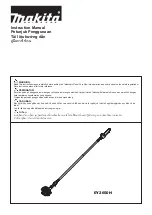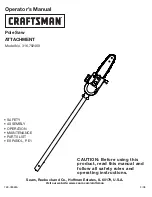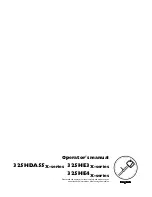
9
Palmgren Operating Manual & Parts List 9683127
OPERATION (CONTINUED)
NOTE: Do not adjust the fence handle such that excessive pressure is
exerted during operation - this may lead to deformation of the end
clamp at the rear of the rip fence. Set the fence handle to apply just
enough pressure to secure fence position during cutting
BLADE SELECTION
• Blades vary depending on type of material, size of workpiece
and type of cut that is being performed.
• Characteristics which make blades different are width, thickness
and pitch.
BLADE WIDTH
• Width of blade describes distance from tip of a tooth to back of
blade.
• Width of blade affects rigidity of blade. A wider blade wanders
less and produces a straighter cut.
• Width of blade also limits the smallest radius which can be cut. A
1/4˝ wide blade can cut about a 1/2˝ radius.
BLADE THICKNESS
• Blade thickness describes the distance between sides of blade. A
thicker blade has more rigidity and stronger teeth.
• A narrow thick blade is used to cut curves while a wide thin
blade is used to make long, straight cuts.
BLADE PITCH
• Pitch describes number of teeth per inch or tooth size. A blade
with more teeth per inch produces a smoother cut.
• The type of material being cut determines number of teeth
which should be in contact with work.
• For soft materials, the proper blade has between 6 to 8 teeth per
inch.
• When cutting hard materials, where shocking is more
detrimental, use a blade with 8 to 12 teeth per inch.
• There should always be at least three teeth in contact with cut to
avoid shocking blade.
• lade shocking occurs when pitch is too large and blade tooth
encounters too much material. This can strip teeth from blade.
• Blade manufacturers are prepared to supply information about
blades for specific applications.
TYPE OF CUT
• Contour cutting is done by guiding workpiece freehanded to
produce curved shapes.
• Beveled cutting is done by tilting saw table and using proper
work guide method.
• Regardless of which work guiding method is used, a workpiece
which overhangs table by more than 5˝ needs proper support.
CONTOUR SAWING
• When contour sawing, use both hands to keep workpiece flat
against table and guided along desired path.
• Avoid positioning hands in line with blade. If hands slip, they
could contact blade.
• Try to stand to front of the saw and use hands over the portion
of table which is to right of blade and before cut.
• Cut small corners by sawing around them. Saw to remove scrap
until desired shape is obtained.
BEVEL CUTTING
Perform bevel cutting by tilting table to desired degree.
1. Unlock table by loosening locking handle located on the
backside of the unit.
2. Tilt table to desired position.
3. Lock table in position by tightening locking handle.
MITER GAUGE
Use miter gauge for securing and holding workpiece at desired
angle to produce angled cuts. Use scale to adjust gauge to desired
angle.
WARNING:
Never use miter gauge and rip fence at the same time. The
blade might bind in the workpiece. Operator could be injured and/or
workpiece could be damaged.
BLADE CLEANING BRUSH
Make sure that brush (located in the lower housing) is in contact
with blade to properly remove foreign particles from drive wheel.
PUSH STICK
The push stick protects against accidental contact with the saw
blade.
• Always use the push stick when the distance between the saw
blade and rip fence is less than 5 inches.
• Hold the push stick at an angle of 25-30 degrees to the table
surface and guide workpiece through the blade.
MAINTENANCE
Steps required to keep the saw in optimum operating condition
have been described under “Operating Instructions.” The Safety
Precautions should be performed before operation.
For proper maintenance:
• Keep saw clean and dry. Sweep off spots where chips have
collected.
• Lubricate the unpainted surfaces with a light application of
medium consistency machine oil to prevent corrosion after
cleaning.
• Replace dull blades and blades from which teeth have been
stripped. A clean saw with a sharp blade will yield the best cut.
• Internal parts of the band saw have been completely lubricated
at the factory and do not need to be relubricated.
WARNING:
Make certain that the saw is disconnected from the power
source before attempting to service or remove any component.
WARNING:
Any attempt to repair the motor may create a hazard
unless repair is done by qualified service technician.


































